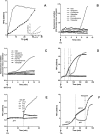LUCS (Light-Up Cell System), a universal high throughput assay for homeostasis evaluation in live cells
- PMID: 29273711
- PMCID: PMC5741755
- DOI: 10.1038/s41598-017-18211-2
LUCS (Light-Up Cell System), a universal high throughput assay for homeostasis evaluation in live cells
Abstract
Observations of fluorescent cyanine dye behavior under illumination at 500 nm lead to a novel concept in cell biology allowing the development of a new live cell assay called LUCS, for Light-Up Cell System, measuring homeostasis in live cells. Optimization of the LUCS process resulted in a standardized, straightforward and high throughput assay with applications in toxicity assessment. The mechanisms of the LUCS process were investigated. Electron Paramagnetic Resonance experiments showed that the singlet oxygen and hydroxyl radical are involved downstream of the light effect, presumably leading to deleterious oxidative stress that massively opens access of the dye to its intracellular target. Reversible modulation of LUCS by both verapamil and proton availability indicated that plasma membrane proton/cation antiporters, possibly of the MATE drug efflux transport family, are involved. A mechanistic model is presented. Our data show that intracellular oxidation can be controlled by tuning light energy, opening applications in regulatory purposes, anti-oxidant research, chemotherapy efficacy and dynamic phototherapy strategies.
Conflict of interest statement
Dr Sylvain Derick and Dr Christophe Furger declare competing financial interest due to patent ownership on LUCS method. Other authors declare no competing financial interest.
Figures





References
-
- Furger, C. Live cell assays, from research to health and regulatory applications (John Wiley & Sons, Hoboken, New Jersey, USA, pp. 248, 2016).
-
- González JE, Maher MP. Cellular fluorescent indicators and voltage/ion probe reader (VIPR) tools for ion channel and receptor drug discovery. Receptor Channels. 2002;28:3–95. - PubMed
Publication types
MeSH terms
Substances
LinkOut - more resources
Full Text Sources
Other Literature Sources

